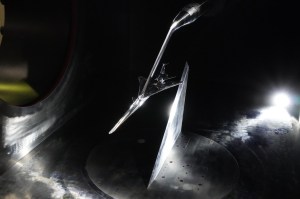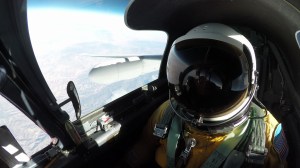
For faster, smarter, safer emergency response operations, the STEReO project (Scalable Traffic Management for Emergency Response Operations) is combining NASA technologies with partnerships to build a system that’s greater than the sum of its parts.
When a natural disaster occurs, an impressive number of participants are often needed to help with the response. Consider just the number of different aircraft that might be involved in fighting a wildfire: tankers releasing fire retardant, lead planes to guide them, helicopters dropping off field crews, aircraft from which smokejumpers arrive on the scene… And that’s to say nothing of the activity taking place on the ground. Responding to an emergency like this – or a hurricane or search and rescue effort, to name a few – requires extensive collaboration among a host of groups that, right now, is coordinated manually under challenging conditions. This makes communication difficult.
New technologies have great potential to assist emergency responders, but they also bring new challenges. For instance, unmanned aircraft systems, commonly called UAS or drones, could make firefighters’ interventions faster, more targeted and better able to adapt to changing environments. However, these aircraft also demand special air traffic management, onboard tools to let them operate independently and safely, and expanded communications to keep everyone aware of what’s happening in the sky and on the ground.
Working to tackle these challenges and more is the Scalable Traffic Management for Emergency Response Operations project, or STEReO, led by NASA’s Ames Research Center in California’s Silicon Valley. By building on NASA technologies and expertise and bringing together solutions from multiple agencies involved in disaster response, STEReO aims to make an impact greater than any solution could have on its own. The work, which is a collaboration between Ames and two other NASA centers – Langley Research Center in Hampton, Virginia, and Glenn Research Center in Cleveland, Ohio – is a concept study under NASA’s Convergent Aeronautics Solutions initiative. The results of the CAS study, designed to determine STEReO’s feasibility, will be used to determine whether and how NASA will pursue further development.
STEReO’s Ecosystem for Emergency Response
STEReO envisions a new ecosystem for emergency response that has three broad goals: reduce response times, scale up the role of aircraft and provide operations that can adapt to rapidly changing conditions during a disaster. To demonstrate how its tools and concepts can achieve these goals in different emergency scenarios, STEReO will conduct a live flight demonstration of a wildfire event and a virtual simulation of a hurricane response.
In both cases, they will build on NASA expertise in diverse areas, including air traffic management, human factors research and autonomous technology development. This background, along with input from collaborators – STEReO’s partners range from federal agencies to city and state fire departments, utilities, and private companies – lets the team explore specific concepts like:
- Applying NASA’s Unmanned Aircraft Systems Traffic Management System, or UTM, to public safety uses, coordinating use of the airspace for both crewed and uncrewed aircraft operations;
- Collaborative tools to take remote sensing information, such as from sensors on aircraft able to find gas leaks after an earthquake, and distribute a common picture of mission operations;
- Communication networks to make the system more resilient to challenging operational environments; and
- Technologies for more autonomous UAS flight to ensure those operations are both safe and responsive to dynamic situations.
STEReO’s approach will bring increased awareness for all partners responding to an emergency, which could allow for earlier detection of problems and rapid decision making. The full package of STEReO’s emergency response ecosystem could also be scaled to the size and complexity of the specific environment, operations and objectives.
2020 Wildfire Fighting Training
In June 2020, STEReO team members attended a training activity for wildland firefighting, learning firsthand about a key role in this type of disaster response: the air tactical group supervisor, who acts as an airborne air traffic controller for all those planes and helicopters that help fight fires. Hosted by the California Department of Forestry and Fire Protection, this was a significant opportunity for the project to assess the current state of operations and understand components needed for their own flight demonstration. The experience revealed new potential collaborations where NASA know-how in air traffic management, UAS autonomy, UTM, and human factors can help these emergency responders do their jobs more effectively and safely.
2021 STEReO Testing with Firefighting Partners
Two events happening in early 2021 are letting the STEReO team test their technologies for communication and coordination in emergency response, working in valuable, hands-on settings with emergency responders.
In the hills east of Phoenix, the team joined the U.S. Forest Service, or USFS, for their annual training academy for aerial supervisors, from Feb. 22 to March 4. While USFS aircraft practiced maneuvers overhead, STEReO tested their tools on the ground. The prototype system collected live, publicly available position data from the USFS planes, and displayed that information on an aerial map hosted on a tablet. Meanwhile, STEReO “flew” simulated UAS operations included on the same map, feeding flight information, such as the positions of the virtual drones and the spaces in which they would operate, into the system.
The result was a first look at how a common operating picture that brings together disparate data sets can improve the awareness of USFS personnel. STEReO’s prototype system included a portable, rather than a cloud-based, UAS service supplier (a software system for coordinating UAS sharing the airspace) that could be used through an ad-hoc wifi network. Both elements are critical for emergency response teams acting in remote areas, for instance, where access to networks and support systems can be scarce. Participants could connect via their own digital device and see the whole picture of firefighting aircraft come together on a common map. The exercise let the Forest Service firefighters test out adding STEReO’s elements to their operations and to give essential user feedback.
From April 26 to May 7, STEReO heads to Redding, California, to work with both the California Department of Forestry and Fire Protection, or CAL FIRE, and the USFS. This wildfire flight demonstration is expected to include NASA drones flying in coordination with firefighting aircraft, putting STEReO’s systems through their paces in an even more realistic context.
Milestones
- STEReO Stakeholder Workshop (Feb. 11-13, 2020)
- Firefighting field work: Air Tactical Group Supervisor Training (June 2020)
- Firefighting field work: U.S. Forest Service National Aerial Supervision Training Academy (Feb. 22-March 4, 2021)
- Airborne assessment of vehicle autonomy work with concurrent operations of NASA piloted and UAS aircraft (April 2021, tentative)
- Airborne assessment of vehicle autonomy work with concurrent operations of two NASA UAS vehicles (April 2021, tentative)
- Wildfire flight demonstration (April 26-May 7, 2021)
Collaborators
NASA’s STEReO team is working with government and industry partners, including the U.S. Forest Service, the Federal Aviation Administration, the California Department of Forestry and Fire Protection, and Avision Inc.
STEReO is an execution activity of NASA’s Convergent Aeronautics Solutions project under the Transformative Aeronautics Concepts Program funded through the Aeronautics Research Mission Directorate.
Learn More
- NASA article: At California Blazes, NASA Team Observes How Drones Fight Wildfire
- NASA article: NASA Tools Could Help Fight Fires – from the Sky and the Ground
- NASA article: NASA Takes on Wildfires with Flight Demonstration
- NASA article: Drones for Disaster Response: NASA STEReO Project Kicks Off
- NASA article: What is Unmanned Aircraft Systems Traffic Management?
For Researchers
- Technical project page: Scalable Traffic Management for Emergency Response Operations
For News Media
- Members of the news media interested in covering this topic should reach out to the NASA Ames newsroom.
































